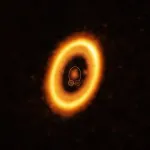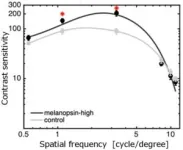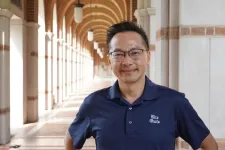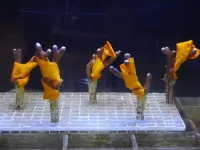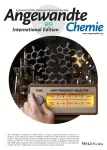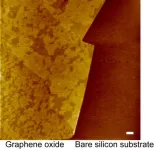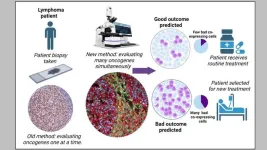(Press-News.org) Using the Atacama Large Millimeter/submillimeter Array (ALMA), astronomers have found the possible ‘sibling’ of a planet orbiting a distant star. The team has detected a cloud of debris that might be sharing this planet’s orbit and which, they believe, could be the building blocks of a new planet or the remnants of one already formed. If confirmed, this discovery would be the strongest evidence yet that two exoplanets can share one orbit.
“Two decades ago it was predicted in theory that pairs of planets of similar mass may share the same orbit around their star, the so-called Trojan or co-orbital planets. For the first time, we have found evidence in favour of that idea,” says Olga Balsalobre-Ruza, a student at the Centre for Astrobiology in Madrid, Spain who led the paper published today in Astronomy & Astrophysics.
Trojans, rocky bodies in the same orbit as a planet, are common in our own Solar System [1], the most famous example being the Trojan asteroids of Jupiter — more than 12 000 rocky bodies that are in the same orbit around the Sun as the gas giant. Astronomers have predicted that Trojans, in particular Trojan planets, could also exist around a star other than our Sun, but evidence for them is scant. “Exotrojans [Trojan planets outside the Solar System] have so far been like unicorns: they are allowed to exist by theory but no one has ever detected them,” says co-author Jorge Lillo-Box, a senior researcher at the Centre for Astrobiology.
Now, an international team of scientists have used ALMA, in which ESO is a partner, to find the strongest observational evidence yet that Trojan planets could exist — in the PDS 70 system. This young star is known to host two giant, Jupiter-like planets, PDS 70b and PDS 70c. By analysing archival ALMA observations of this system, the team spotted a cloud of debris at the location in PDS 70b’s orbit where Trojans are expected to exist.
Trojans occupy the so-called Lagrangian zones, two extended regions in a planet's orbit where the combined gravitational pull of the star and the planet can trap material. Studying these two regions of PDS 70b’s orbit, astronomers detected a faint signal from one of them, indicating that a cloud of debris with a mass up to roughly two times that of our Moon might reside there.
The team believes this cloud of debris could point to an existing Trojan world in this system, or a planet in the process of forming. “Who could imagine two worlds that share the duration of the year and the habitability conditions? Our work is the first evidence that this kind of world could exist,” says Balsalobre-Ruza. “We can imagine that a planet can share its orbit with thousands of asteroids as in the case of Jupiter, but it is mind blowing to me that planets could share the same orbit.”
“Our research is a first step to look for co-orbital planets very early in their formation,” says co-author Nuria Huélamo, a senior researcher at the Centre for Astrobiology. "It opens up new questions on the formation of Trojans, how they evolve and how frequent they are in different planetary systems,” adds Itziar De Gregorio-Monsalvo, ESO Head of the Office for Science in Chile, who also contributed to this research.
To fully confirm their detection, the team will need to wait until after 2026, when they will aim to use ALMA to see if both PDS 70b and its sibling cloud of debris move significantly along their orbit together around the star. “This would be a breakthrough in the exoplanetary field,” says Balsalobre-Ruza.
"The future of this topic is very exciting and we look forward to the extended ALMA capabilities, planned for 2030, which will dramatically improve the array’s ability to characterise Trojans in many other stars," concludes De Gregorio-Monsalvo.
Notes
[1] When asteroids in Jupiter’s orbit were first discovered, they were named after heroes of the Trojan war, giving rise to the name Trojans to refer to these objects.
More information
This research was presented in a paper to appear in Astronomy & Astrophysics.
The team is composed of O. Balsalobre-Ruza (Centro de Astrobiología [CAB], CSIC-INTA, Spain), I. De Gregorio-Monsalvo (European Southern Observatory [ESO], Chile), J. Lillo-Box (CAB), N. Huélamo (CAB), Á. Ribas (Institute of Astronomy, University of Cambridge, UK), M. Benisty (Laboratoire Lagrange, Université Côte d’Azur, CNRS, Observatoire de la Côte d’Azur, France and Univ. Grenoble Alpes, CNRS, IPAG, France), J. Bae (Department of Astronomy, University of Florida, USA), S. Facchini (Dipartimento di Fisica, Università degli Studi di Milano, Italy), and R. Teague (Department of Earth, Atmospheric, and Planetary Sciences, Massachusetts Institute of Technology, USA).
The European Southern Observatory (ESO) enables scientists worldwide to discover the secrets of the Universe for the benefit of all. We design, build and operate world-class observatories on the ground — which astronomers use to tackle exciting questions and spread the fascination of astronomy — and promote international collaboration for astronomy. Established as an intergovernmental organisation in 1962, today ESO is supported by 16 Member States (Austria, Belgium, the Czech Republic, Denmark, France, Finland, Germany, Ireland, Italy, the Netherlands, Poland, Portugal, Spain, Sweden, Switzerland and the United Kingdom), along with the host state of Chile and with Australia as a Strategic Partner. ESO’s headquarters and its visitor centre and planetarium, the ESO Supernova, are located close to Munich in Germany, while the Chilean Atacama Desert, a marvellous place with unique conditions to observe the sky, hosts our telescopes. ESO operates three observing sites: La Silla, Paranal and Chajnantor. At Paranal, ESO operates the Very Large Telescope and its Very Large Telescope Interferometer, as well as survey telescopes such as VISTA. Also at Paranal ESO will host and operate the Cherenkov Telescope Array South, the world’s largest and most sensitive gamma-ray observatory. Together with international partners, ESO operates ALMA on Chajnantor, a facility that observes the skies in the millimetre and submillimetre range. At Cerro Armazones, near Paranal, we are building “the world’s biggest eye on the sky” — ESO’s Extremely Large Telescope. From our offices in Santiago, Chile we support our operations in the country and engage with Chilean partners and society.
The Atacama Large Millimeter/submillimeter Array (ALMA), an international astronomy facility, is a partnership of ESO, the U.S. National Science Foundation (NSF) and the National Institutes of Natural Sciences (NINS) of Japan in cooperation with the Republic of Chile. ALMA is funded by ESO on behalf of its Member States, by NSF in cooperation with the National Research Council of Canada (NRC) and the National Science and Technology Council (NSTC) in Taiwan and by NINS in cooperation with the Academia Sinica (AS) in Taiwan and the Korea Astronomy and Space Science Institute (KASI). ALMA construction and operations are led by ESO on behalf of its Member States; by the National Radio Astronomy Observatory (NRAO), managed by Associated Universities, Inc. (AUI), on behalf of North America; and by the National Astronomical Observatory of Japan (NAOJ) on behalf of East Asia. The Joint ALMA Observatory (JAO) provides the unified leadership and management of the construction, commissioning and operation of ALMA.
Links
Research paper
Photos of ALMA
For journalists: subscribe to receive our releases under embargo in your language
For scientists: got a story? Pitch your research
Contacts
Olga Balsalobre-Ruza
PhD student at Centre for Astrobiology (CAB, CSIC-INTA)
Madrid, Spain
Tel: +34 918131531
Email: obalsalobre@cab.inta-csic.es
Itziar De Gregorio-Monsalvo
ESO Head of the Office for Science Chile
Santiago, Chile
Tel: +56 (2) 2463 3000
Email: idegrego@eso.org
Jorge Lillo-Box
Researcher at Centre for Astrobiology (CAB, CSIC-INTA)
Madrid, Spain
Tel: + 34 918131309
Email: jorge.lillo@cab.inta-csic.es
Nuria Huélamo Bautista
Researcher at Centre for Astrobiology (CAB, CSIC-INTA)
Madrid, Spain
Tel: +34 918131530
Email: nhuelamo@cab.inta-csic.es
Bárbara Ferreira
ESO Media Manager
Garching bei München, Germany
Tel: +49 89 3200 6670
Cell: +49 151 241 664 00
Email: press@eso.org
END
Does this exoplanet have a sibling sharing the same orbit?
2023-07-19
ELSE PRESS RELEASES FROM THIS DATE:
Michael Wong named fellow of the Royal Society of Chemistry
2023-07-19
HOUSTON – (July 19, 2023) – Rice University’s Michael Wong was named a fellow to the Royal Society of Chemistry (RSC), the oldest chemical society in the world, whose mission is to “advance excellence in the chemical sciences.” More than 180 years old, the United Kingdom-based chemical society has over 54,000 members worldwide.
“It’s a confirmation that the work we do in our group is something that people appreciate and is making a meaningful contribution ...
From nature, a solution to save coral from climate change
2023-07-19
Genoa (Italy), 19 July 2023 – Researchers at Istituto Italiano di Tecnologia (Italian Institute of Technology - IIT) and Università degli Studi di Milano-Bicocca (University of Milan-Bicocca), in cooperation with Acquario di Genova (Genoa Aquarium) in Italy, have recently published a study in ACS Applied Materials and Interfaces, which demonstrates the efficacy of curcumin, a natural antioxidant substance extracted from turmeric, in reducing coral bleaching, a phenomenon caused primarily by climate change. The research group developed a biodegradable biomaterial to deliver the molecule without ...
Dementia risk and disadvantaged neighborhoods
2023-07-19
About The Study: The results of this study of 1.6 million patients suggest that residence within more disadvantaged neighborhoods was associated with higher risk of dementia among older veterans integrated in a national health care system.
Authors: Christina S. Dintica, Ph.D., of the University of California, San Francisco, is the corresponding author.
To access the embargoed study: Visit our For The Media website at this link https://media.jamanetwork.com/
(doi:10.1001/jamaneurol.2023.2120)
Editor’s Note: Please see the article for additional information, including other authors, author ...
Does cognitive function after retirement differ across race and sex?
2023-07-19
A study published in the Journal of the American Geriatrics Society found that immediately after retirement, white adults tended to experience a significant decline in cognitive function, whereas Black adults experienced minimal cognitive decline. White men showed the steepest post-retirement cognitive decline across sex/race combinations, whereas Black women showed the least decline.
White women performed better cognitively at retirement than other race/sex subgroups, and after retirement, their cognitive functioning declined at a rate that was slightly ...
Can parents’ Disability Insurance boost children’s economic mobility?
2023-07-19
New research published in Contemporary Economic Policy indicates that Disability Insurance (DI) may improve economic opportunities for children whose parents have health conditions that limit work.
The study included 52,575 parent-child pairs in the United States. When investigators examined economic mobility patterns for children whose parents reported work-limiting disability, they found that children had less upward economic mobility and more downward mobility relative to children of non-limited parents. Children of parents ...
Nurse-home visiting program may boost child language and mental health
2023-07-19
A randomized controlled trial conducted in Canada and published in the Journal of Child Psychology and Psychiatry found that Nurse-Family Partnership (NFP), a nurse-home visiting program, improved child language and mental health at age 2 years when compared with existing services. Rates of child injuries and maternal subsequent pregnancies were similar in the two groups.
This real-world effectiveness trial involved sustained research-policy-practice collaborations from 2011–2022. Investigators successfully reached/enrolled and sustained engagement with 739 participants (368 NFP, 371 comparison) and their 737 children for ...
How effective is Functional Family Therapy for addressing youth behavior problems?
2023-07-19
Functional Family Therapy is a family-based intervention for youth with behavior problems, and although it’s been implemented in 45 states in the U.S and in nine other high-income countries, a recent analysis of published and unpublished studies found that the therapy is not consistently more or less effective than other treatments, including various forms of individual, family, and group interventions.
The authors of the analysis, which is published in Campbell Systematic Reviews and included 20 studies, also noted that there is insufficient evidence ...
Developing NMR method for drug structure elucidation
2023-07-19
In the late 1950s and 1960s, more than 12,000 malformed babies with short arms and legs were born as a side effect of thalidomide, a drug sold to pregnant women to prevent morning sickness. The tragedy was caused by the drug's side effect, which exists in a racemic mixture of two mirror-image forms. Research to determine the molecular structure of various compounds is essential for understanding biological phenomena and developing drugs to treat diseases and is mainly based on the interpretation ...
Concentration of cell membrane components with nanocarbon materials
2023-07-19
Overview
A research team from the Department of Applied Chemistry and Life Science at the Toyohashi University of Technology (Professor Ryugo Tero et al.) discovered a phenomenon in which specific lipids were concentrated on graphene oxide in a multicomponent lipid bilayer membrane serving as a cell membrane model. This research team also clarified the mechanism by which the components of “lipid rafts" (where important cell membrane reactions such as neurotransmission and metabolism occur) gather owing to the surface characteristics of graphene oxide. This discovery is ...
NUS researchers develop novel approach for predicting resistance against cancer therapy
2023-07-19
A team of researchers from the Cancer Science Institute of Singapore (CSI Singapore) at the National University of Singapore (NUS), led by Assistant Professor Anand Jeyasekharan, has discovered a unique combination of oncogenes that could predict treatment resistance, and hence unfavourable outcomes, of patients with Diffuse large B cell lymphoma (DLBCL), the most common type of blood cancer in Singapore and globally.
This unique oncogenic combination, serving as an indicator of treatment resistance, can be detected through state-of-the-art technology. The researchers, however, went a step ...
